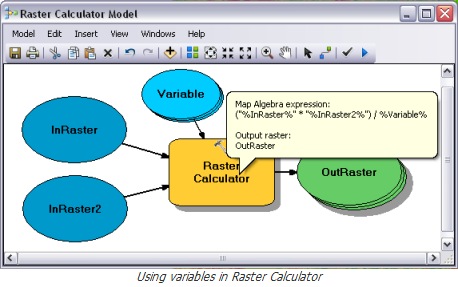
- #COMPARE RASTER CALCULATOR AND MODEL BUILDER HOW TO#
- #COMPARE RASTER CALCULATOR AND MODEL BUILDER DOWNLOAD#
Now to create a new model or geoprocessing tool, all I have to do is right click on it and go to new model. And what I'll get when it finishes adding it is a new tool box with nothing in it called DEM tools. And then find that folder, click on it once again and then click open. So right click on ArcToolbox we're going to add toolbox. So let's go and add it to ArcToolbox again. And now I don't have to add it to ArcToolbox but I tend to like to. In this case we're doing Toolbox and I'm going to call it DEM Tools. On the folder that you want and go to New > Toolbox. In the catalog window, right click on it.

So find a working directory on your computer somewhere, and. So to start with let's create a new tool box that we can put our tool in. That roster calculator step though can be a little error prone and so we might want to make a model for it so that we can save time of running two steps, and that we can have consistent results. And then we can use the roster calculator to find all of the cells in the aspect roster that faced toward the south. Well we've done this before in on of the assignments, what we need to do is we need to run the aspect to wall on the digital elevation model. Or it's that you can use it for vegetation analysis, or solar influx, or something like that. And that you have the digital elevation model or you can obtain it from somewhere, but you really need to find all of the south facing slopes that you could find it. Let's say that you regularly need to take a new area of interest and find all of the south facing slopes for it.
#COMPARE RASTER CALCULATOR AND MODEL BUILDER HOW TO#
So I'm going to show you how to create a brand new model and then how to add tools to it, link them together and make your own geoprocessing tool out of it. In this lecture we're going to dive into Model Builder by building our own model for the first time. By completing the fourth class you will gain the skills needed to succeed in the Specialization capstone. You should have equivalent experience to completing the first, second, and third courses in this specialization, "Fundamentals of GIS," "GIS Data Formats, Design, and Quality", and "Geospatial and Environmental Analysis," respectively, before taking this course. Take Geospatial and Environmental Analysis as a standalone course or as part of the Geographic Information Systems (GIS) Specialization. Finally, we'll wrap up by talking about a few more things that you might want to explore more as you start working on learning about GIS topics on your own. Week 4: We'll begin the final week by talking about a few spatial analyst tools we haven't yet touched on in the specialization: Region Group to make our own zones, Focal Statistics to smooth a hillshade, Reclassify to change values, and Point Density to create a density surface. We'll also go through a few common algorithms including a very important one: the suitability analysis. Week 3: In week three, we'll make and use digital elevation models using some new, specific tools such as the cut fill tool, hillshades, viewsheds and more.

We'll also explore a few topics that we don't really have time to discuss in detail, but might whet your appetite for future learning in other avenues: geocoding, time-enabled data, spatial statistics, and ArcGIS Pro. Week 2: You'll learn how to use ModelBuilder to create large processing workflows that use parameters, preconditions, variables, and a new set of tools.

#COMPARE RASTER CALCULATOR AND MODEL BUILDER DOWNLOAD#
At the end of this week, you'll be able to find and download satellite imagery online and use it for two common types of analysis: NDVI and trained classification.

Week 1: You'll learn all about remotely sensed and satellite imagery, and be introduced to the electromagnetic spectrum. In this class you will become comfortable with spatial analysis and applications within GIS during four week-long modules: Using the knowledge you’ve learned about ArcGIS, complete technical tasks such raster calculations and suitability analysis. Welcome to the last course of the specialization (unless your continuing on to the capstone project, of course!).


 0 kommentar(er)
0 kommentar(er)
